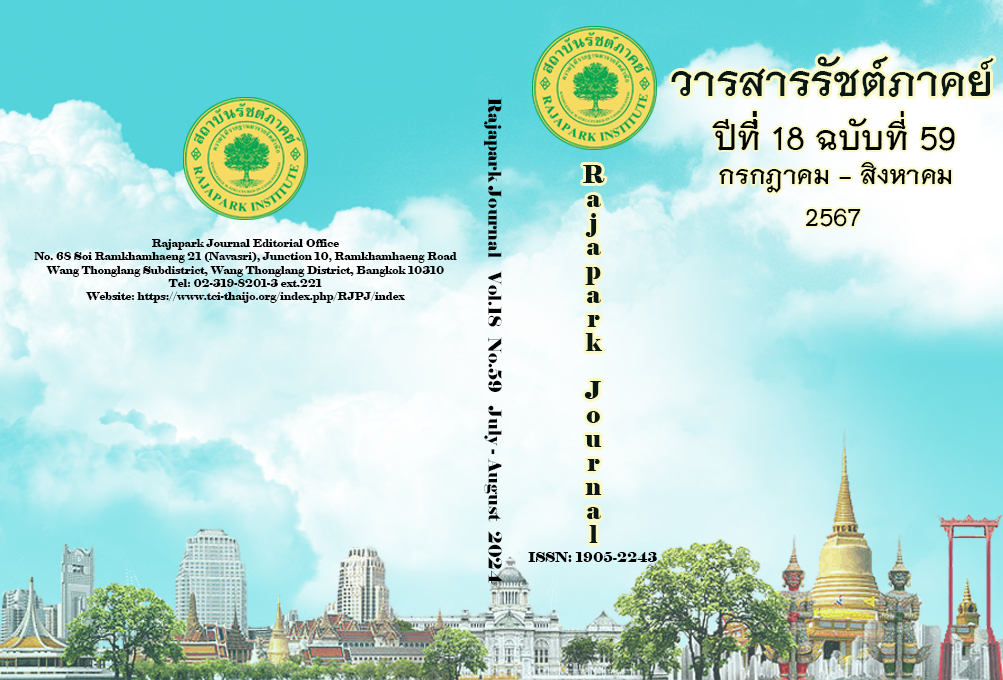Guidelines for Increasing Farmers’ Income from Rice Straw Management for Stopping Burning on Agricultural Fields in Thailand
Main Article Content
Abstract
Burning rice straw causes environmental, social, and economic problems. However, nowadays, it is found that rice straw can be used in various ways to generate income for farmers. This article reviews the literature on rice straw quantity and rice straw utilization in Thailand and analyzes the ways to create income from using rice straw instead of burning it in the future in two simulation situations. Scenario 1 is the analysis of the increasing rate of rice straw utilization to 25% in 2027, creating an added value of 19,162 million baht, increasing 30% in 2031, creating an added value of 24,936 million baht, and increasing another 35%, and in 2036, additional value can be created at 33,663 million baht. Scenario 2 is the analysis of the limitations of energy utilization and opportunities in energy utilization. In 2027, the use of livestock will have an increase in energy transmission limitations to 400,000 tons, with a total value from benefits of 17, 3734 million baht. As of 2031, there are restrictions on the use of compost, resulting in energy use increasing to 1.9 million tons with a total value from benefits of 19,110 million baht. In 2036, a limited proportion will be used for energy to support the circular economy, causing the proportion of energy use to increase to 4.5 million tons and have a total value of 20,292 million baht, which is in line with the pollution control policy in 2036.
Article Details

This work is licensed under a Creative Commons Attribution-NonCommercial-NoDerivatives 4.0 International License.
Views and opinions appearing in the Journal it is the responsibility of the author of the article, and does not constitute the view and responsibility of the editorial team.
References
Bourapa, R., Tika, T., Srakaew, W., Sintala, K., Kuha, K., & Chaiwong, S. (2021). Study of rice strew and corn husk with fermented of lactic acid bacteria and yeast on rumen degradability and metabolizable energy using in vitro gas production technique. Khon Kaen Agriculture Journal, Suppl. 1, 469-475.
Cheewaphongphan, P., Junpen, A., Kamnoet, O., & Garivait, S. (2018). Study on the potential of rice straws as a supplementary fuel in very small power plants in Thailand. Energies, 11(2), 270. https://doi.org/10.3390/en11020270
Dassanayake, GDM., & Kumar, A. (2012). Techno-economic assessment of triticale straw for power generation. Applied Energy, 98, 236-245. https://doi.org/10.1016/j.apenergy.2012.03.030
Delivand, MK., Barz, M., & Garivait, S. (2011). Overall analyses of using rice straw residues for power generation in Thailand-project feasibility and environmental GHG impacts assessment. Journal of Sustainable Energy & Environment Special Issue, 39-46. https://www.researchgate.net/publication/268179192
Department of Livestock Development (2022). Information on the number of livestock in Thailand 2022. Department of Livestock Development.
Diep, N.Q., Sakanishi, K., Nakagoshi, N., Fujimoto, S., & Minowa, T. (2015). Potential for rice straw ethanol production in the Mekong Delta, Vietnam. Renewable Energy, 74, 456-463. https://doi.org/10.1016/j.renene.2014.08.051
Gadde, B., Menke, C., & Wassmann, R. (2009). Rice straw as a renewable energy source in India, Thailand, and the Philippines: Overall potential and limitations for energy contribution and greenhouse gas mitigation. Biomass and Bioenergy, 33(11), 1523-1546. https://doi.org/10.1016/j.biombioe.2009.07.018
Indian Agricultural Research Institute (2012). Crop residues management with conservation agriculture: Potential, constraints and policy needs. Indian Agricultural Research Institute.
Korenaga, T., Liu, X., & Huang., Z. (2001). The influence of moisture content on polycyclic aromatic hydrocarbons emission during rice straw burning. Chemosphere-Global change Science, 3(1), 117-122. https://doi.org/10.1016/S1465-9972(00)00045-3
Mahmood, A., & Gheewala, H.S. (2020). A comparative assessment of rice straw management alternatives in Pakistan in a life cycle perspective. Journal of Sustainable Energy & Environment, 11, 21-29. https://www.researchgate.net/publication/344905195
Muliarta, LN. (2019). A study on rice field farmer implementation of rice straw composting. IOP Conference Series: Earth Environmental Science, 343. DOI: 10.1088/1755-1315/343/1/012001
Nguyen, D. (2019). Review of postharvest rice straw use: Change in use and the need for sustainable management policies in Vietnam. Journal Vietnam Environment, 11(2). DOI: 10.13141/jve.vol11.no2.pp95-103
Office of Agricultural Economics. (2022). Agricultural economic information 2022. Office of Agricultural Economics.
Office of Agricultural Economics. (2022, Nov 27). Management of “rice straw” in the 8 central provinces to create additional value. Office of Agricultural Economics. https://www.oae.go.th
Office of Natural Resources and Environmental Policy and Planning (2022). Report number of farmers and organic farming area (2017-2021). Office of Natural Resources and Environmental Policy and Planning.
Office of Natural Resources and Environmental Policy and Planning. (2024). Environmental Quality Management Plan 2023 - 2027. Office of Natural Resources and Environmental Policy and Planning.
Pandey, S., Ryerlee D., Dawe D., Dobermann, A., Mohanty, S., Rozelle, S., & Hardy, B. (2010). Rice in the global economy: Strategic research and policy issues for food security. Los Baños (Philippines): International Rice Research Institute – IRRI.
Ren, J., Yu, P., & Xu, X. (2019). Straw utilization in China—status and recommendations. Sustainability, 11(6), 1762. https://www.mdpi.com/2071-1050/11/6/1762
Reyes, R. G. (2000). Indoor cultivation of paddy straw mushroom. Mycologist, 14(4), 174-176. https://doi.org/10.1016/S0269-915X(00)80037-3
Saothongnoi, V., Amkha, S., Inubushi, K., & Smakgahn, K. (2014). Effect of rice straw incorporation on soil properties and rice yield. Thai Journal of Agricultural Science, 47(1), 7-14. https://www.researchgate.net/publication/290010979
Sudha, A., Geetha P. & Rajesh, M. (2019). Antioxidant properties of paddy straw mushroom (Volvariella volvacea (Bull. ex Fr.) sing. International Journal of Current Microbiology and Applied Sciences, 8(2), 3031-3036. DOI: https://doi.org/10.20546/ijcmas.2019.802.355
Thailand Environment Institute. (2022). Managing and reducing burning in agricultural areas of Thailand. Thailand Environment
Institute.
The Mushroom Researchers and Growers Society of Thailand. (2014). Economic mushrooms an opportunity to create a career create income. The Mushroom Researchers and Growers Society of Thailand.


